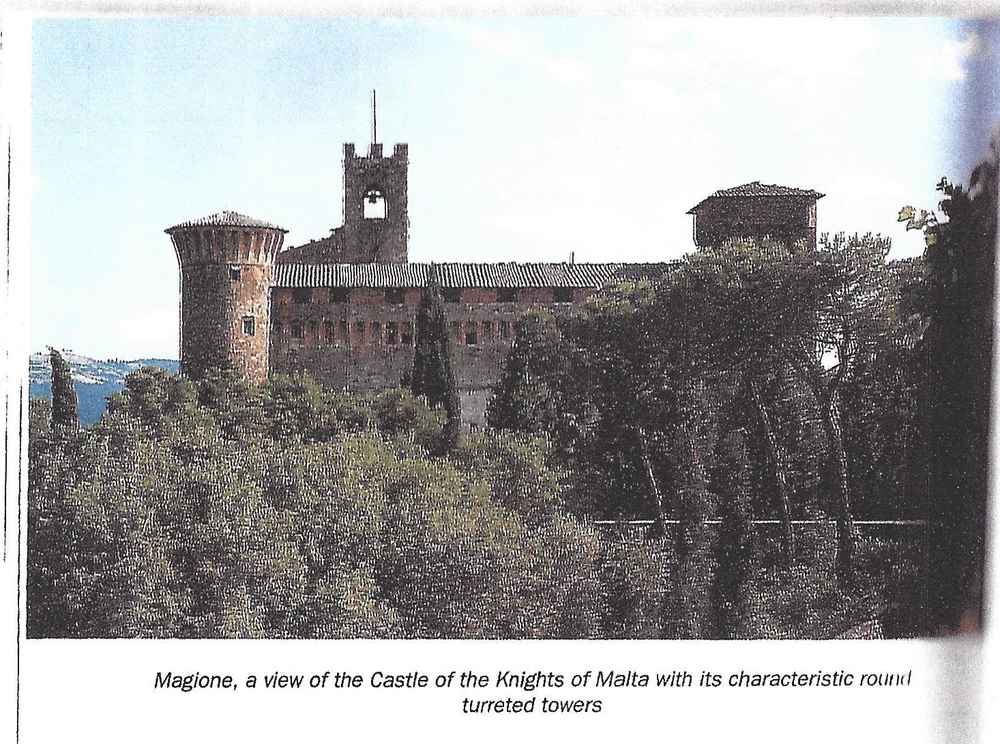Saints, Knights and Wine

Under the spiritual guidance of Rev. Jonathan Farrugia from Rome and Malta, and Deacon Harold Jopp, a group of us traveled to Italy in October, 2015, exploring the history of the Order in Umbria and Friuli and visiting the churches and shrines of the many saints in the area.
We were directed by Bill Williams, KM, whose travel agency in Front Royal, Va. organizes trips to Malta and Order-related sites in Italy. With Janice Klich, DM, Elizabeth Rubino, DM, Mary and Richard Zabelski, and me rounding out our group, the pilgrimage started with a visit to the Grand Priory of Lombardy, where members extended generous hospitality.
Proceeding to Padua and the Basilica of St. Anthony, built in the 13th century, we visited one of the chapels containing relics of the tongue and chin of St. Anthony as well as his cassock. There, we also visited the tomb of St. Luke, the patron of physicians.
Traveling throughout Umbria with its natural beauty and peaceful atmosphere, one appreciates how this land has been a perfect setting for prayer and contemplation.
One such location was Castello di Maggiore on the banks of Lake Trasimeno, a magnificent estate built in the 12th century as a hospital for pilgrims traveling to Rome and Jerusalem. It was the summer residence of the Grand Master for many years. Many popes and sovereigns have stayed there.
In the oldest part is a chapel dedicated to St. John the Baptist, with beautiful frescoes representing the Virgin and Child, St. John the Baptist and St. James. The castle museum includes extensive memorabilia of the history of the Order in its collection. Here we had the pleasure of meeting Giulia Luccioli, Director of the Order of Malta Wine Estates, who gave us a tour and wine tasting. We also visited the vineyards of Rocca Bernardo, a 15th century estate in Friuli, now owned by the Order of Malta. It is set in a traditional landscape of ancient cypress trees and breathtaking scenery. Father Jonathan celebrated Mass in Rocca's private oratory.
So, with our reliable driver, Marco, guides Father Jonathan and Bill Williams, we traveled each day through beautiful countryside in the footsteps of the saints and to visit their churches and shrines. One of them, the sanctuary of Castelmonte, is considered one of the oldest sanctuaries in Italy, dating back to the late Roman period. It occupies a strategic position and originally was a military outpost on the borders of Slovenia.
In Foligno, we visited the Church of St. Francis which contains the mortal remains of Beata Angela of Foligno, a 14th century mystic. There we also stopped by St. Bartholomew's Friary, which is famous for a true replica of the Holy Sepulchre Chapel in Jerusalem, built in 1645 to allow pilgrims to visit the same sepulchre as in Jerusalem without having to travel there.
In Spoleto Cathedral, the reliquary chapel contains a letter written and signed by St. Francis of Assisi. It is one of two known signatures of the saint that has survived, the other being on display in Assisi.
Another special stop was the town of Cascia, where St. Rita, was born and spent her whole life. We visited the Basilica and the Monastery of St. Rita, the tomb of Blessed Teresa Fasce and the relic of the Eucharistic miracle.
Crossing into Tuscany, we visited the Church of St. Margaret of Cortona and the Shrine of St. Christina, and took a tour of the catacombs in Bolsena.
The trip ended in the city of Orvieto, where we were privileged to attend Mass in the Capella Nuova at the cathedral. This chapel contains the magnificent painting of The Last Judgement, considered to be one of the greatest frescoes in Italian art.

